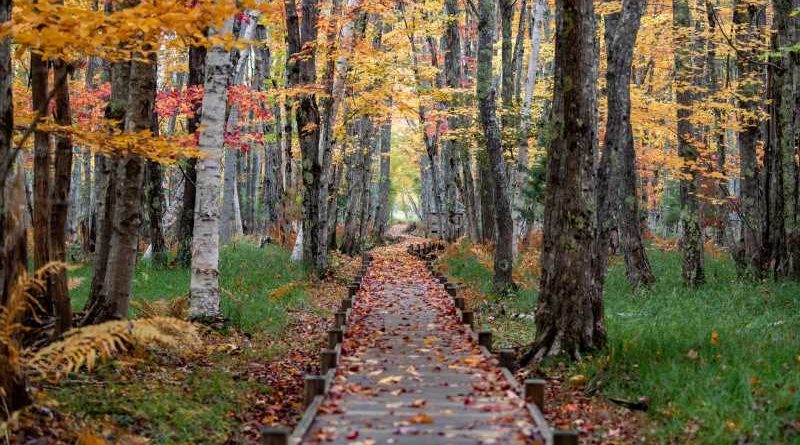7 of the best national parks for wheelchair users
Load Error
National parks have long been some of America’s greatest assets, but over the past year, they have gained even more popularity. Thanks to huge outdoor spaces where social distancing is easy to do, more and more people are flocking to national parks to see the country’s natural beauty.
While it’s fantastic that the national parks are finally getting the recognition they deserve, some aspects of them can often be challenging for wheelchair users. Rough terrain and steep trails are associated with many of the nation’s most-known outdoor experiences, but there are a variety of phenomenally wheelchair-accessible national parks as well. From easy-to-traverse trails to scenic drives and overlooks, many of America’s national parks cater to all travelers. Here are seven of the best national parks for wheelchair users to explore.
For more TPG news delivered each morning to your inbox, sign up for our daily newsletter.
Acadia National Park
As New England’s only national park, Acadia is well worth the visit if you find yourself in Maine. It has everything from accessible beaches and picnic areas to wheelchair-friendly trails, making this a place where you can enjoy the best of what Maine has to offer.
Acadia National Park has free shuttles that can take visitors to nearby village centers and accessible shuttles are available for guests that need them. If you’re looking to visit the beach, Echo Lake is the most accessible beach option in Acadia. It has wheelchair-accessible parking spots and restrooms, and even an accessible path to the water.
Related: A beginner’s guide to visiting Acadia National Park
Lastly, you can’t visit a national park and not check out the trails. Luckily, Acadia has a few accessible trail options. Jesup Path winds through a white birch forest and has a boardwalk path, making it the smoothest trail for wheelchair users, but Acadia’s 45-mile carriage road system is a smooth and fun way for wheelchair users to roll through the national park as well. If you prefer to actually ride in a carriage instead of wheeling the carriage roads on your own though, two wheelchair-accessible carriages are available at Wildwood Stables.
Carlsbad Caverns National Park
Unlike most national parks, you won’t be spending a ton of time in the great outdoors while at Carlsbad Caverns. Instead, you’ll be descending underground into the largest accessible cave chamber in North America. While it hasn’t always been accessible, it is now thanks to an elevator that carries wheelchair users more than 750 feet underground in approximately one minute.
Located in the Guadalupe Mountains of New Mexico, Carlsbad Cavern is one of the most stunning caverns in the world. After taking the elevator down, you will be in the “Big Room” cave chamber, which has over a mile of paved trails. From the trails, limestone formations are visible in every direction. Most of the paved trail is easily accessible, but some sections can be steep and narrow, so use caution and plan to bring a companion with you in case assistance is needed during the self-guided tour.
Related: The most wheelchair-accessible beach destinations in the US
Grand Canyon National Park
Is it possible to talk about national parks and not mention the Grand Canyon? Absolutely not in this case because the Grand Canyon is hands-down one of the most wheelchair-accessible national parks in the country. It’s a bucket-list destination for many people of all abilities and for good reason!
The Grand Canyon has the North and South rims and while the North Rim does have a visitor center, scenic drives and is certainly worth visiting, the South Rim is by far the most popular. It’s also the most accessible.
Related: Machu Picchu — one of Peru’s greatest tourist attractions — gets even more wheelchair accessible
The South Rim has accessible shuttle buses, a visitor center and many wheelchair-friendly viewpoints and trails. The Trail of Time is a must-do 1.3-mile trail that goes from Verkamp’s Visitor Center to the Yavapai Geology Museum. Along the Trail of Time, you’ll learn interesting facts and take in the stunning views of the canyon. It’s a trail with views unlike anywhere else on Earth. If you’d like to spend the night at the Grand Canyon, accommodations are available at the South Rim, but it’s highly recommended to book your stay as far in advance as possible since they get booked up well in advance.
Gallery: Stunning photos from Utah’s Mighty 5 national parks (USA TODAY)
Great Sand Dunes National Park
Sand dunes and wheelchairs usually aren’t the best combination, but at Great Sand Dunes National Park in Colorado, it’s possible to have a remarkable time if you’re a wheelchair user. In recent years, this national park has become quite accessible, so there’s never been a better time to visit.
The Visitor Center has a limited number of special sand wheelchairs available to navigate the dunes more easily. The sand wheelchairs are similar to a manual beach wheelchair with large inflatable tires. To be able to use one of the sand wheelchairs, you’ll just need to leave your ID at the Visitor Center and return the chair at least 30 minutes before the Visitor Center closes for the day. You can also reserve a sand wheelchair in advance by calling 719-378-6395.
In addition to rolling in the dunes, there are also free ranger programs available, which are accessible, and picnic areas. One wheelchair-friendly picnic site is available and it even has a smooth trail to an accessible restroom. Great Sand Dunes is one of the country’s lesser-known national parks, but it is a beautiful place to visit and incredibly accessible.
Related: Exploring national parks: Where to stay using points
Great Smoky Mountains National Park
Great Smoky Mountains National Park is the nation’s most visited national park and also one of the largest, stretching into both Tennessee and North Carolina. The national park is 95% forest, so there are many trails to explore and quite a few wheelchair-accessible options.
Two must-do drivable trails are Cades Cove and the Roaring Fork Motor Nature Trail. Cades Cove has an 11-mile drivable loop and even though that may seem like a short distance, it can take anywhere from two to four hours to complete, as there is a lot to see. On a typical drive through Cades Cove, you can see deer, turkeys, bears and more wildlife. Similar to Cades Cove, Roaring Fork Motor Nature Trail is also drivable and gives you the ability to spot wildlife within the park. At 5 1/2 miles, Roaring Fork is half the length of Cades Cove, but it’s equally impressive and even has a waterfall known as Place of a Thousand Drips.
Related: A beginner’s guide to visiting Great Smoky Mountains National Park
If you’d rather get out of your vehicle and roll on some accessible trails, there are a few different trails for you. Sugarlands Valley Nature Trail is the most accessible option, as it is fully paved and flat. It’s a half-mile long and much of it runs by a river. Another accessible trail is the Little River Trail and while it isn’t paved, it is fairly smooth and flat for the first mile (2 miles round-trip).
Shenandoah National Park
Located in Virginia, Shenandoah National Park is a gorgeous place to enjoy the outdoors. Like the Great Smoky Mountains, it has both drivable routes and accessible trails.
Skyline Drive is the only public road in Shenandoah National Park and at 105 miles long, it goes through the whole park. The road is paved, so it’s easy to drive and takes about three hours if you drive the entirety of it. Along the route, you will likely see wildlife, but there are 69 overlooks as well, where you can pull over and take in the views of Shenandoah Valley. About 25% of the scenic overlooks have wheelchair-accessible parking spots, giving you the opportunity to get out of your vehicle for some nice photos.
Limberlost Trail is the park’s only fully accessible trail, but it’s one of the best in the country for wheelchair users. This trail is a 1.3-mile loop and it’s flat and smooth, being primarily made of crushed greenstone. Another trail that isn’t quite as accessible, but still possible for many wheelchair users, is Rose River Trail. The first mile of Rose River Trail is bumpy in some sections due to being a dirt road with gravel, but it’s possible in a motorized wheelchair. Scooters or manual wheelchairs may have a bit more difficulty. After a mile of rolling, you’ll see Dark Hollow Falls, a waterfall that makes the trek completely worth it.
Related: 8 national parks that are spectacular in spring
Yellowstone National Park
This national park is located in three states; Idaho, Montana and Wyoming. As one of the most iconic national parks in the world, Yellowstone is a place that everyone should visit at least once and luckily, it is extremely accessible.
Access to popular attractions at Yellowstone, such as the Old Faithful geyser, is easy. There are multiple accessible paths and complimentary wheelchairs are even available to use from the Old Faithful, Grand Canyon, Mammoth (Albright), Norris and Fishing Bridge visitor centers on a first-come, first-served basis.
Yellowstone National Park offers so many experiences to enjoy, including seeing amazing wildlife and even fishing. An accessible fishing area is available on the Madison River at the Mount Haynes Overlook. Accessible picnic areas are also in the Madison area.
Related: A beginner’s guide to visiting Yellowstone National Park: Everything you should see and do
Bottom line
The seven national parks above are spectacular destinations for wheelchair users, but they are in no way the only accessible national parks. America’s National Park System is fantastic and nearly all parks have at least some degree of accessibility, so start exploring no matter what your abilities are.
Related: 7 air travel tips for wheelchair users
Featured photo by Harry Collins/EyeEm/Getty Images.
SPONSORED: With states reopening, enjoying a meal from a restaurant no longer just means curbside pickup.
And when you do spend on dining, you should use a credit card that will maximize your rewards and potentially even score special discounts. Thanks to temporary card bonuses and changes due to coronavirus, you may even be able to score a meal at your favorite restaurant for free.
These are the best credit cards for dining out, taking out, and ordering in to maximize every meal purchase.
—
Editorial Disclaimer: Opinions expressed here are the author’s alone, not those of any bank, credit card issuer, airlines or hotel chain, and have not been reviewed, approved or otherwise endorsed by any of these entities.
Source: Read Full Article




